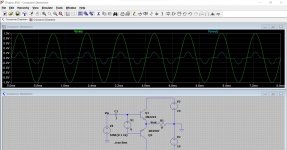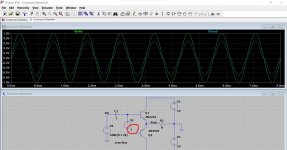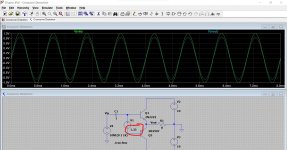whats the main reason for distortion, even at very low volume levels?
there doesnt appear to be anything wrong with the amp, voltages etc
could it be a dodgy transistor? pre amp? /or power😕
there doesnt appear to be anything wrong with the amp, voltages etc
could it be a dodgy transistor? pre amp? /or power😕
Last edited:
Crossover distortion is most noticeable at low level and is caused by having almost zero bias current.
A scope would show it clearly.
A scope would show it clearly.
Try this. Change the DC voltage V1 to set the bias current. The third image is at just a couple of milliamps and the distortion is gone.
Can you see why the distortion happens?
Can you see why the distortion happens?
Attachments
its def not the pre amp as i swaped over the pre/power connectors.Crossover distortion is most noticeable at low level and is caused by having almost zero bias current.
A scope would show it clearly.
its distorted at all volumes, mainly transient type ,like stringed instruments/piano etc
i thought it might be the driver or pre driver section of the power amp maybe if one of the transistors had failed??
First thing to check is that all the power supply rails are present and correct, there is negligible DC-offset on the output, all connectors are solidly in place. There are many possible causes for distortion, troubleshooting narrows down where the problem is - for instance one channel only or both channels?
Then there's scope for comparative troubleshooting - checking various voltages and seeing where the differences are between channels, if you feel safe working on a live amp. Disconnet speakers and check DC offsets first though.
Crossover distortion would always be from the power amp, not the preamp.
so problem solved on this one Q612 emitter faulty, sounds great now, so if the evening goes like that, ill be a happy bunny
i noticed there wasnt a lot of juice on the base of Q616 so thats it realy apart from this noise on start up.
I changed caps C532,533 and C531(100v) but it still makes that noise, not realy sure what to do about that, if anything? it doesnt realy affect the amps performance, it is anoying though as i havent has this with other 3020 units
i was thinking of shorting out the 2 FETS and bypassing it? update, that didnt work.
Last edited:
Well done with the transistor 🙂 An unusual fault as it is one of the drivers... I have a theory however 😉
You need to test the mute circuit carefully. If you short out C531 the amp should mute 'fairly' silently. You can just carefully stick a screwdriver across it as a test.
When you remove the short it should unmute 'fairly' silently.
You need to test the mute circuit carefully. If you short out C531 the amp should mute 'fairly' silently. You can just carefully stick a screwdriver across it as a test.
When you remove the short it should unmute 'fairly' silently.
Short it out when the amp is playing at low level and see if it mutes OK. When you remove the short the audio should come back in a second or two. You can turn it on with the cap shorted and it should stay in mute.
so yes to both, it does mute music shorted and comes back on silently
ive tried all the known work arounds, check all paths to ground and the diodes, all ok
you can here the FETS engage as the both operate,one channel then moments later the other
ive tried all the known work arounds, check all paths to ground and the diodes, all ok
you can here the FETS engage as the both operate,one channel then moments later the other
Last edited:
And what about switching on with it shorted?
That's where it gets tricky because the negative voltage takes a moment to build up and during that time the mute isn't effective.
Also the power amp itself will almost certainly make some noise that is unrelated to what is being fed into it from the preamp.
Try it though, see how quiet it all is when turned on with the cap shorted. Give the amp a decent time OFF before turning back on to allow everything to discharge back to how a cold start would be.
That's where it gets tricky because the negative voltage takes a moment to build up and during that time the mute isn't effective.
Also the power amp itself will almost certainly make some noise that is unrelated to what is being fed into it from the preamp.
Try it though, see how quiet it all is when turned on with the cap shorted. Give the amp a decent time OFF before turning back on to allow everything to discharge back to how a cold start would be.
still makes the noise shorted out
one thing ive noticed, R548 says its a 150K resistor, but a 100k is installed, also the volt in/out should be 29v/20.9 but it is actualy 36v/21v so the voltage drops are different but with the right end result-strange just shows you cant always trust whats writen down all the time.
one thing ive noticed, R548 says its a 150K resistor, but a 100k is installed, also the volt in/out should be 29v/20.9 but it is actualy 36v/21v so the voltage drops are different but with the right end result-strange just shows you cant always trust whats writen down all the time.
So I think you might be chasing something that can't really be improved... a limitation of the design.
R548 (and R547) set a static DC level that bias the FET's fully on. You can calculate the voltage expected by the resistors values fitted and the supply voltage.
Production changes are normal in lots of equipment and this does not always carry through to the service manual.
R548 (and R547) set a static DC level that bias the FET's fully on. You can calculate the voltage expected by the resistors values fitted and the supply voltage.
Production changes are normal in lots of equipment and this does not always carry through to the service manual.
So I think you might be chasing something that can't really be improved... a limitation of the design.
R548 (and R547) set a static DC level that bias the FET's fully on. You can calculate the voltage expected by the resistors values fitted and the supply voltage.
Production changes are normal in lots of equipment and this does not always carry through to the service manual.
Well that was short lived plugged in this morning and it sounds dreadful so God knows what's gone wrong there 🤔 realy distorted. I still recon its got something to do with that noise on switch on. Oh well will report back later
So I think you might be chasing something that can't really be improved... a limitation of the design.
R548 (and R547) set a static DC level that bias the FET's fully on. You can calculate the voltage expected by the resistors values fitted and the supply voltage.
Production changes are normal in lots of equipment and this does not always carry through to the service manual.
so this one is ok now.I was getting realy high idle current, so i checked all the transistors and they were all ok, but i did find a bit of broken track on one of them and the 1ohm resistor blown(odd) but put it all back together and works perfectly, so it must have been the broken track as the 1ohm plays no part once shorted out.both channels 0 centre and 30mv idle now as per the spec.(still get that buzz on turn on and thats bugging me a bit) but there you go.
- Home
- Amplifiers
- Solid State
- Harmonic distortion



 chalk that one up as a success.
chalk that one up as a success.